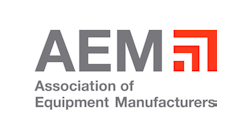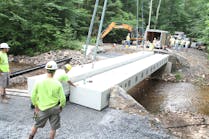Training: McCarthy Construction Named in Top 10 of Employee Development— and Training’s Only Part of It
For the fourth year in a row, McCarthy Building Companies Inc., a St. Louis-based construction firm with 2014 revenues approaching $3 billion, has been named in the top ten of Training magazine’s Top 125 training programs. The highest-rated construction company, this year McCarthy held the number seven slot on the list. Critical criteria for award selection included “demonstrated effectiveness” of training programs that contributed to achieving “key corporate strategic goals.”
Exactly what the company ordered, says McCarthy’s Director of Learning and Development Robin Renschen. We caught up with Renschen during a break in his travel schedule for some insights about how this employee-owned company has pushed training into a multi-faceted learning and development experience.
“The company had just come off of some really incredible years in the early- to mid-2000s, when people couldn’t catch their breath. Management decided that rather than taking a reactive approach and playing catch-up, it would be more productive to formalize some of these strategies and see what it could bring in the years to come. Essentially they said, ‘We’re doing great now, but how could we get even better?'”
Renschen came onboard in 2008, in the middle of the recession. “We knew we needed to find new ways to plug into the company’s key business needs to determine where we could provide impact. I was hired to change our approach to developing talent at all levels, from new-hire engineers right out of college all the way up to our vice presidents in operations. ‘Training’ had been a reactive solution. Someone’s going to be promoted to project manager; we should probably get him or her some training. That’s fine, but it’s not necessarily aligned with the skills and experience an individual might already have compared with they might need in their new position. So we started to talk about things like ‘proficiency’ and created what we call our Gap Analysis process. This involves a very simple conversation between the manager and the individual, in which the manager conducts an analysis of the person’s skills and where they might be lacking, either because of lack of experience or exposure or because they’re new. The manager uses a rating scale to develop an idea of where the person is prepared and where they will need to develop.”
McCarthy Construction particularly wanted a training and employee development solution that would scale with the business, what Renschen describes as, “A more deliberate focus toward identifying and developing our future leaders.” This necessarily involved educating executives and managers on the differencebetween management and leadership skill development. “There are certain project management skills that apply, whether someone’s a brand new manager or has been doing it for 20 or 30 years. These could include anything from delegation to negotiation to communication, very basic skills that a manager of people or things needs to develop. Beyond those skills, leadership comes into play. In helping an individual develop leadership skills, there’s a great emphasis on self-awareness. We focus on motiving, influencing, and empowering people—how do you get a subcontractor who’s off schedule back on course, for example. This is a completely different skill set.”
Approximately twice a year the company offers Management 101, a four-to five-month entry-level management course. Individuals are nominated as part of the company’s Talent Review and Succession planning process. Division staffs work with the executive team and the department of human resources (HR) in a formal annual process that reviews employees, while throughout the year, the HR director works with Renschen’s Learning and Development group to evaluate up-and-coming managers and leaders—”Let’s talk about Bob Smith as a project manager. What do we think is in store for him for the next 5–10 years? What developmental needs does he have? What are our options? Would Management 101 be a very good first developmental step for him?”
The 24–26 candidates attend webinars, undertake self-study and undergo on-the-job training, where they work with their manger on activities and exercises, and in some cases in small groups, on an Action Learning assignment before they attend a week-long workshop. “We leverage all of these program, and after about eight weeks, we fly the 24–26 participants to St. Louis for a very intensive one-week program.
“We’ve already laid a foundation of some core skills so at the workshop we can demonstrate and practice some of those skills and not take valuable face time teaching theory. The third phase is to create their Action Plan, in which they identify specific gaps or skills they want to work on once they’re back on the job.” The Action Plan demonstrates another key aspect of the program—that employees are expected to be actively involved in their own job development and career advancement. “We set a meeting with the individual’s manager and review the employee’s plan. This helps bring the manger into supporting his or her development. Then for the next 90–120 days, the individual takes time to apply the skills they’ve learned, supported by various other touch points along the way.”
What happens if an individual’s promotion is off-cycle with Management 101? “In collaboration with our HR director, and using our Action Plan template, we’ll assemble other developmental solutions to fill the gap and supplement until Management 101 comes around again.” Meaning? “We might work with this person’s manager and identify three skill areas that need development. The manager and the individual talk through possible solutions that he or she can work on for the next six months. It might be an ad hoc project they can take complete ownership of, with certain defined steps, what the manager considers the desired outcome, and the metric that defines how their performance will be measured.”
How is the effectiveness of these programs demonstrated? “Don’t over-think measurement,” advises Renschen. “Look for natural ties where you can build the data collection process into the training solution ahead of time. Particularly in this industry, you have to look for non-standard returns on investment. In most cases, people don’t come into training, learn a new production technique, and widget production increases by 10%. When you teach someone to be a better builder, the results can take years and can be very hard to measure. What we’re saying is, ‘You don’t just say we’re got a problem, let’s train everybody.’ Because in a lot of cases, what we think of as classic training may not the right solution. The problem could be related to how a team is structured or a bad or out-of-date procedure or policy or a missing procedure or policy, or relationship issues.
“So first you look at what data is available in light of whatever the problem is and ask yourself what this tells you. You start to understand what the causes of the problem are and consider that there might be a number of different solutions, of which training is one. If training does turn out to be an issue, you build the training on the specific technique or application in a way that if it’s done differently, the solution will impact the data. If our data was x when the problem occurred, and the appropriate employees go through training, at some point in the future when we rerun the analysis the new data says y—meaning, the goal being that the situation has improved. In the case of issues related to water quality, for example, we identified certain projects, tracked the people who went through training, and determined that we were able to reduce our water-related costs by about 95%, and in the process developed an approach that could be replicated.
“In another area, one of my colleagues introduced a change in approach that included a customer-focused sales strategy, which we were able to document resulted in over $900 million in sales. We’re very clear in communicating those successes with our executive teams, managers, and our leaders. We want to market the Learning and Development Department as a partner you might go to in the same way you’d go the Legal or Risk Management departments. As such, we want to emphasize that our approach might not always involve training, and may include activities such as systems and procedure analysis.
“As an employee-owned company, every dollar we spend is securitized; initiatives are reviewed and vetted to make sure they’re well focused, involve the appropriate personnel groups and are good investments. Imagine a grid of about 20 boxes. You put ‘Training’ in one box then you fill in the other 19 with activities like ‘On-the-Job Learning,’ ‘Mentoring Programs,’ ‘Coaching,’ etc. It’s not that an employee ‘needs training’—send him to us and when he comes out the other end, he’s fixed. To be successful, the employee’s manager has to be accountable as well as the employee himself.”








